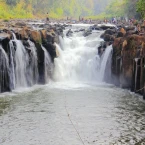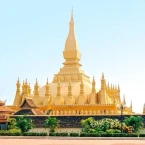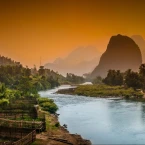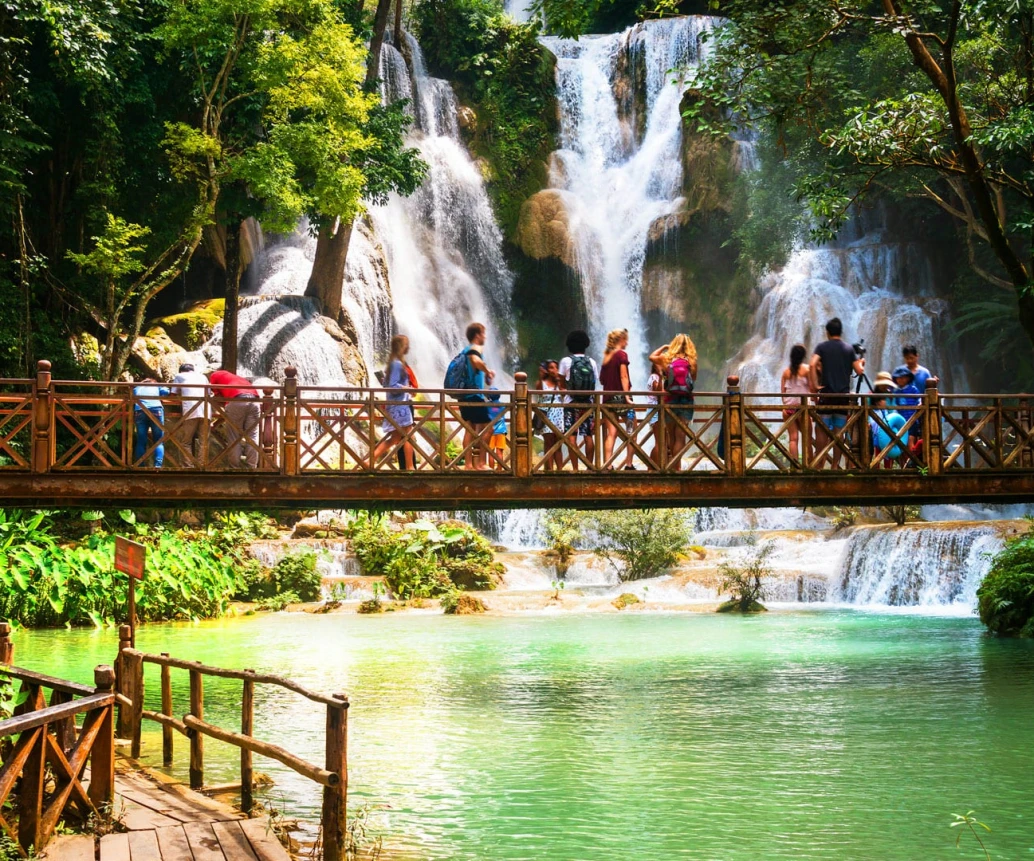
Top 20 Things To Do In Laos For First-Time Visitors
Content []
Laos is an ideal destination for those who want to explore unique culture and pristine nature. With a variety of experiences ranging from historical sites to adventurous activities, Laos promises an unforgettable trip. Let’s discover the top 20 things you must do when visiting Laos for the first time!
Table of Contents
- 1. Pha That Luang – The Golden Symbol of the Land of a Million Elephants
- 2. Patuxai – The Victory Monument of Vientiane
- 3. Wat Sisaket – The Oldest Temple in Vientiane
- 4. Lao Textiles – The Art of Traditional Weaving
- 5. Haw Phra Kaew – Once the Home of the Emerald Buddha
- 6. Wat Si Muang – Where Belief and Spirit Converge
- 7. Buddha Park – A Surreal Garden of Sculptures
- 8. Talat Sao – Vientiane’s Bustling Morning Market
- 9. Bolaven Plateau – Land of Waterfalls and Coffee
- 10. Plain of Jars – Laos’ Ancient Archaeological Mystery
- 11. Wander Through History at Vat Phou – Laos’ Khmer Ruins
- 12. Snap a Photo at the Presidential Palace – A French-Colonial Icon
- 13. Learn About Laos’ Past at the COPE Visitor Centre
- 14. Reconnect with Nature at Pha Tad Ke Botanical Garden
- 15. Feel the Power of Nature at Tad Yuang Waterfall
- 16. Kayaking or Hot Air Ballooning in Vang Vieng
- 17. Take a Scenic Cruise Along the Mekong River
- 18. Swim in Paradise: The Turquoise Pools of Kuang Si Waterfall
- 19. Slow Travel in the 4000 Islands
- 20. Soar Through the Jungle: Zipline Adventure in Bokeo Nature Reserve
1. Pha That Luang – The Golden Symbol of the Land of a Million Elephants
Pha That Luang is the most sacred golden stupa in Vientiane, regarded as the national symbol of Laos. Its architecture embodies traditional Lao design, with elegant curves and a radiant golden hue that gleams in the sunlight. It hosts major religious festivals such as the annual That Luang Festival.
Beyond its religious importance, the stupa reflects national pride and the spirit of independence. Visitors can stroll around its spacious grounds and explore the smaller stupas and Buddha statues nearby. Late afternoon is an ideal time to admire the breathtaking sunset reflected on the golden dome. Don’t forget your camera — this place is a photographer’s dream.
2. Patuxai – The Victory Monument of Vientiane
Patuxai is a memorial monument dedicated to those who fought for Laos' independence, located in the heart of Vientiane. The structure combines French colonial architecture with intricate Lao-style carvings and decorations. Inside, visitors can climb to the top for a panoramic view of the city — a must-do experience.
Surrounding Patuxai is a public park with fountains and green spaces, ideal for walking or relaxing. In the evenings, both tourists and locals gather here to unwind. More than just a monument, Patuxai stands as a proud emblem of resilience and peace.
3. Wat Sisaket – The Oldest Temple in Vientiane
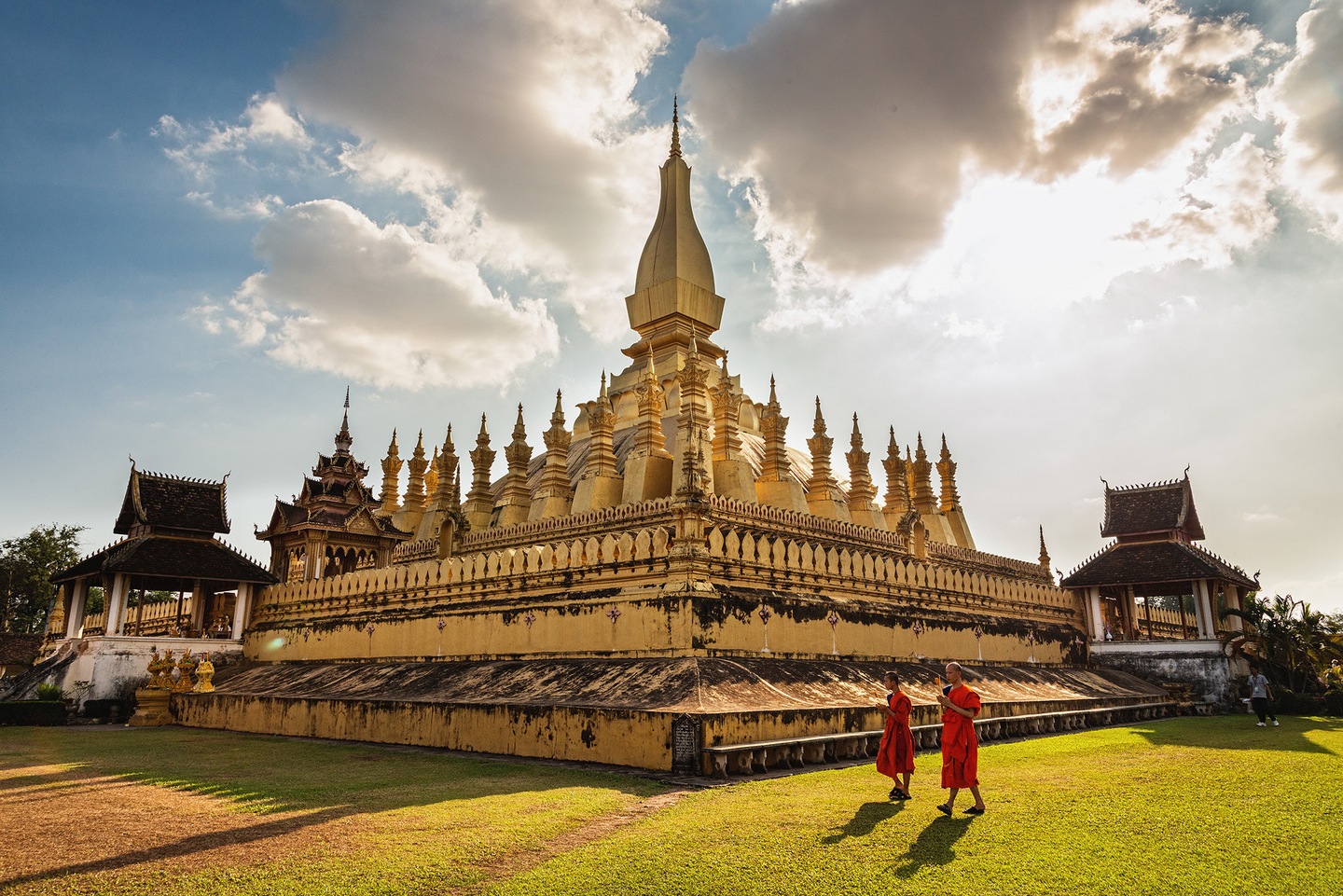
Wat Sisaket is the only temple that remained intact after the 19th-century Siamese invasion. Its most fascinating feature is the thousands of tiny Buddha statues placed in niches along the cloister walls. The temple’s peaceful and ancient atmosphere offers a deep spiritual experience. It also houses old manuscripts of Buddhist scriptures written in Pali. With a blend of Thai and Lao architecture, Wat Sisaket is a treasure trove of history, religion, and art. For those interested in Buddhist heritage, this temple is not to be missed.
4. Lao Textiles – The Art of Traditional Weaving
Hand-weaving is an essential part of Lao culture, especially in artisan villages like Ban Phanom in Luang Prabang. Silk fabrics are intricately woven by hand, featuring motifs rich in cultural and spiritual meaning. Visitors can watch the entire weaving process-from spinning and dyeing to the final product.
Some workshops even offer hands-on experiences where you can create your own textile piece. Handmade items such as scarves and embroidered bags make meaningful souvenirs. It's also a great way to learn about the vital role women play in Lao society.
5. Haw Phra Kaew – Once the Home of the Emerald Buddha
Haw Phra Kaew is a historic temple that once housed the sacred Emerald Buddha, now located in Bangkok. Though the statue is no longer here, the temple remains an iconic religious and cultural site in Vientiane. It now functions as a museum, displaying rare Buddhist artifacts like ancient statues, wood carvings, and scriptures.
Its architecture features classic Lao design with multi-tiered roofs and intricate details. The tranquil space allows visitors to appreciate the spiritual depth and historical value of the site. A must-visit for those passionate about art, history, and religion.
6. Wat Si Muang – Where Belief and Spirit Converge
Wat Si Muang is one of Vientiane’s most revered temples, believed to bring luck and spiritual protection to the city. The temple’s origin is tied to a tragic legend of a woman who sacrificed herself during its construction.
Today, people come here to pray for blessings, fertility, health, and success. The vibrant red and gold temple is adorned with beautifully arranged Buddha images and sacred statues. The scent of incense and quiet prayers create a sacred atmosphere. If you’re curious about Lao spiritual practices, this is the place to feel their essence.
7. Buddha Park – A Surreal Garden of Sculptures
Located about 25 km from Vientiane, Buddha Park (Xieng Khuan) features over 200 unusual Buddhist and Hindu statues. Designed by a monk-artist, the sculptures are whimsical, surreal, and sometimes eerie-unlike anything you’d expect.
Highlights include a massive reclining Buddha and a giant pumpkin-shaped sculpture symbolizing hell, earth, and heaven. Visitors can climb inside and explore the different levels. The park's dreamlike setting is perfect for artistic photography and cultural curiosity. Although small, it leaves a big impression and offers a unique perspective on Lao spirituality.
8. Talat Sao – Vientiane’s Bustling Morning Market
Talat Sao is a lively market where you can find everything from traditional Lao fabrics and jewelry to electronics and handicrafts. It's not just a shopping destination but also a vibrant cultural space reflecting everyday Lao life. The food court offers local dishes like khao jee, tam mak hoong, and sticky rice.
Friendly vendors are happy to chat and share stories behind their goods. While not a luxury shopping experience, it’s rich in authenticity and charm. If you want to immerse yourself in local culture, Talat Sao is a must-visit.
9. Bolaven Plateau – Land of Waterfalls and Coffee
Situated in southern Laos, the Bolaven Plateau is known for its cool climate, majestic waterfalls, and lush coffee plantations. It's ideal for nature lovers, trekkers, and anyone seeking an escape into rural beauty. Famous waterfalls like Tad Fane and Tad Yuang are breathtaking with their thunderous cascades and jungle surroundings.
Visitors can tour coffee farms, learn about production, and sip freshly brewed Arabica or Robusta. The plateau also offers a chance to interact with ethnic minority communities. A peaceful retreat for those who crave tranquility and natural charm.
10. Plain of Jars – Laos’ Ancient Archaeological Mystery
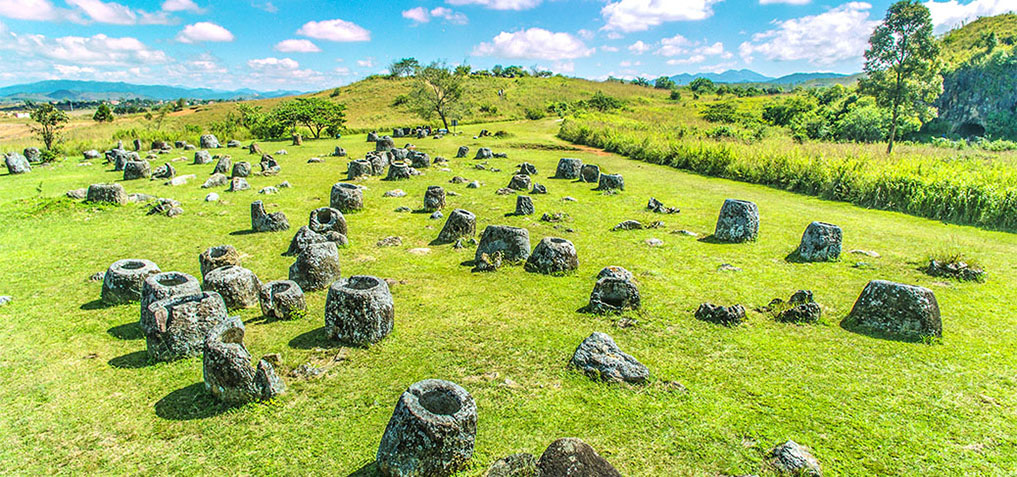
The Plain of Jars in Xieng Khouang province is one of Laos’ most enigmatic and captivating sites. Thousands of massive stone jars, some thousands of years old, are scattered across open fields. Their original purpose remains unknown - theories range from burial urns to rice wine storage.
This mystery only adds to the site’s allure. Although heavily bombed during past conflicts, cleared areas are now open for exploration. For history buffs and curious minds, the Plain of Jars is a rare window into ancient civilizations and unexplained relics.
11. Wander Through History at Vat Phou – Laos’ Khmer Ruins
Step back in time as you explore Vat Phou, the ancient Khmer temple complex nestled at the foot of Mount Phou Kao. Recognized as a UNESCO World Heritage Site, this sacred site predates Angkor Wat and showcases intricate sandstone carvings and spiritual architecture. As you wander through the weathered ruins, you’ll uncover the religious and cultural importance the site once held in the Khmer Empire.
Surrounded by stunning natural scenery, the quiet atmosphere adds a sense of mystery and awe. The journey to Vat Phou, whether by road or by boat along the Mekong, is an experience in itself. Every corner whispers stories from centuries past. For history buffs and curious souls alike, this is a place not to be missed. Feel the connection between ancient civilization and the spiritual spirit of Laos.
12. Snap a Photo at the Presidential Palace – A French-Colonial Icon
Located in the heart of Vientiane, the Presidential Palace is an architectural gem from the French colonial period. Although not open to the public, the grand facade and regal iron gates make it a popular photo spot. With classic French details, soft pastel colors, and elegant design, the palace embodies the colonial past of Laos.
Framed by palm trees and beautifully manicured gardens, the structure offers a charming glimpse into political and architectural history. It's especially striking at sunset when the light reflects warmly off its walls. A stop here allows travelers to appreciate the city’s layered identity. Don't forget your camera – this is one of the capital's most photogenic landmarks. Even just viewing it from outside leaves a strong impression.
13. Learn About Laos’ Past at the COPE Visitor Centre
The COPE Visitor Centre in Vientiane is a powerful place to understand the unexplored chapter of Laos’ modern history. This center provides a moving look into the legacy of unexploded ordnance (UXO) left from the Vietnam War era. Through real stories, interactive exhibits, and informative displays, visitors learn about the people affected and the ongoing efforts to clear bombs and provide rehabilitation. It’s a sobering yet inspiring visit that highlights resilience and recovery.
Admission is free, but donations support vital work. Visiting COPE is more than just a stop – it's a reminder of how Laos continues to heal. This is an essential experience for anyone seeking deeper insight into the country. Prepare to leave with a heart full of compassion and admiration.
14. Reconnect with Nature at Pha Tad Ke Botanical Garden
Accessible only by boat from Luang Prabang, Pha Tad Ke Botanical Garden is a serene retreat dedicated to biodiversity and conservation. Spread across lush hills and riverbanks, this garden introduces you to native plant species, traditional herbal medicine, and sustainable agriculture practices. Guided tours and workshops make the visit both educational and relaxing.
Walk through shaded bamboo groves, orchid houses, and fragrant herb gardens, where every step brings you closer to Laos’ natural wonders. The peaceful ambiance is ideal for unwinding from city life. The garden also supports local communities and researchers. A café overlooking the Mekong offers a scenic rest stop before your return. This is where nature and culture intertwine beautifully.
15. Feel the Power of Nature at Tad Yuang Waterfall

Tad Yuang Waterfall, located on the Bolaven Plateau, is a breathtaking display of raw natural beauty. Water thunders down twin streams into a refreshing pool below, surrounded by lush jungle. The area features well-maintained paths and viewing platforms for panoramic views. You can also descend to the base for a closer experience and even a swim.
In the morning, mist rises over the falls, creating a magical atmosphere for photographers. Local stalls nearby offer traditional coffee and souvenirs. It’s an ideal stop on a loop through the coffee-growing highlands. Tad Yuang is a perfect blend of scenic splendor and accessibility. Come here to feel rejuvenated and awed by the power of water.
16. Kayaking or Hot Air Ballooning in Vang Vieng
Vang Vieng is no longer just a party hub – it's a haven for adventure seekers looking for natural excitement. Paddle your way through dramatic limestone karsts on a kayak, or glide above them in a hot air balloon at sunrise. The town offers a wide range of outdoor thrills, from caving and rock climbing to river tubing.
Each activity reveals a new angle of this breathtaking landscape. The Nam Song River is central to the experience, offering fun and tranquility alike. Safety standards have improved, making it friendly for families and groups. After your adventures, relax with sunset views by the riverbank cafés. Vang Vieng proves that adrenaline and serenity can exist in harmony.
17. Take a Scenic Cruise Along the Mekong River
A cruise along the Mekong River is one of the most enchanting ways to experience Laos. Whether it’s a slow boat from Huay Xai to Luang Prabang or a short sunset cruise, the river reveals life unfolding along its shores. Watch fishermen cast their nets, children play, and monks meditate in riverside temples.
The ever-changing scenery – from forested cliffs to sleepy villages – is meditative and timeless. Onboard, enjoy local meals, cool breezes, and the rhythm of the water. This journey invites reflection and deep appreciation for the country’s soul. It’s not just transportation – it’s a cultural immersion. Let the Mekong show you the heart of Laos.
18. Swim in Paradise: The Turquoise Pools of Kuang Si Waterfall
Just outside Luang Prabang, Kuang Si Waterfall is a postcard-perfect escape into a natural wonderland. Water cascades over limestone terraces into crystal-clear turquoise pools, ideal for swimming. Shaded paths lead through the forest, offering multiple viewing spots. At the base, a Bear Rescue Centre adds an educational touch to your visit. Early morning is best to avoid crowds and catch the pools at their most peaceful. Bring a picnic and spend the day lounging in nature. The cool water provides welcome relief from the tropical heat.
Kuang Si is more than a tourist stop – it’s a slice of paradise. One visit and you'll understand why it’s a traveler favorite.Traveling to Laos is not just about sightseeing - it’s a profound journey into the peaceful, simple, and deeply spiritual way of life of the local people. With its harmonious blend of nature and culture, Laos is becoming an increasingly appealing destination, offering visitors truly meaningful and memorable experiences.
19. Slow Travel in the 4000 Islands
The 4000 Islands (Si Phan Don) in southern Laos offer a peaceful escape where time seems to slow. Among the best ways to explore Don Det and Don Khon is by bicycle, riding along quiet dirt paths. You’ll pass wooden houses, rice fields, and water buffalo lazing in the sun.
Stop at tiny riverside cafés, local temples, or the remnants of the old French railway. Along the way, spot rare Irrawaddy dolphins and enjoy the simple charm of island life. There are no cars, no rush – just the rhythm of the Mekong and rustling palms. Biking here brings you closer to daily life and nature. It’s the essence of slow, soulful travel.
20. Soar Through the Jungle: Zipline Adventure in Bokeo Nature Reserve
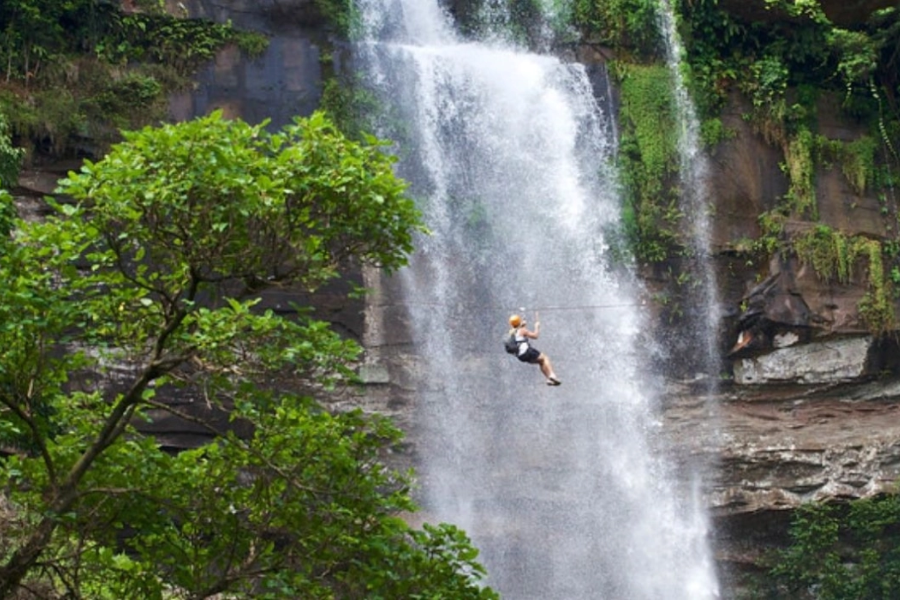
Bokeo Nature Reserve is home to the Gibbon Experience, a one-of-a-kind zipline and treehouse adventure in northern Laos. Fly through the forest canopy, hundreds of feet above the jungle floor, with panoramic views all around. Spend the night in treehouses only accessible by zipline, listening to the calls of gibbons at dawn. The experience blends conservation, adventure, and pure thrill.
Guided treks take you through lush rainforest, where you may spot rare wildlife. Eco-conscious and immersive, it supports preservation efforts in the region. This isn’t just an activity – it’s a deep dive into Laos’ wild heart. For those who crave something truly unforgettable, the jungle awaits.
Laos is a country that enchants with its quiet grace, deep spirituality, and untouched beauty. Whether you're drawn to ancient temples, misty mountains, or vibrant markets, this peaceful land offers something for every kind of traveler. These 20 experiences are just the beginning - each one opens a door to a deeper connection with the soul of Laos. Prepare to slow down, look closer, and be moved.
Read this next
Quick Contact
WHAT DO CUSTOMERS SAY ABOUT US?
See Real Experiences from Our Travelers

